What Are Those Red and White Poles For?
By Robert Kelly
I’m sure that everyone has seen those red and white poles either mounted on the trails of a gun or howitzer or on the side of an armoured vehicle. I wrote about the red and white posts a number of years ago on the old WWPD site and decided to dust it off and update after reading a recent Facebook post asking “what are those red and white poles for”? So many people were trying to be helpful to the person asking the question but at the same time being so completely wrong that I felt I had to do something about it. I served 18 years in the Royal Canadian Artillery, so I feel qualified to answer that question. I’ll be describing how the Commonwealth artillery would use them, but the procedures are almost the same for most other armies.
The short answer is that they are “aiming posts”. The longer answer is that they are cleaning staves painted up to look like aiming posts. So, what exactly are aiming posts and what are they used for? First of all aiming posts are only used for indirect fire weapons such as artillery guns and howitzers or mortars.
Photos of aiming posts in action are hard to come by but here is one of an American “Redleg” running out the far aiming post.
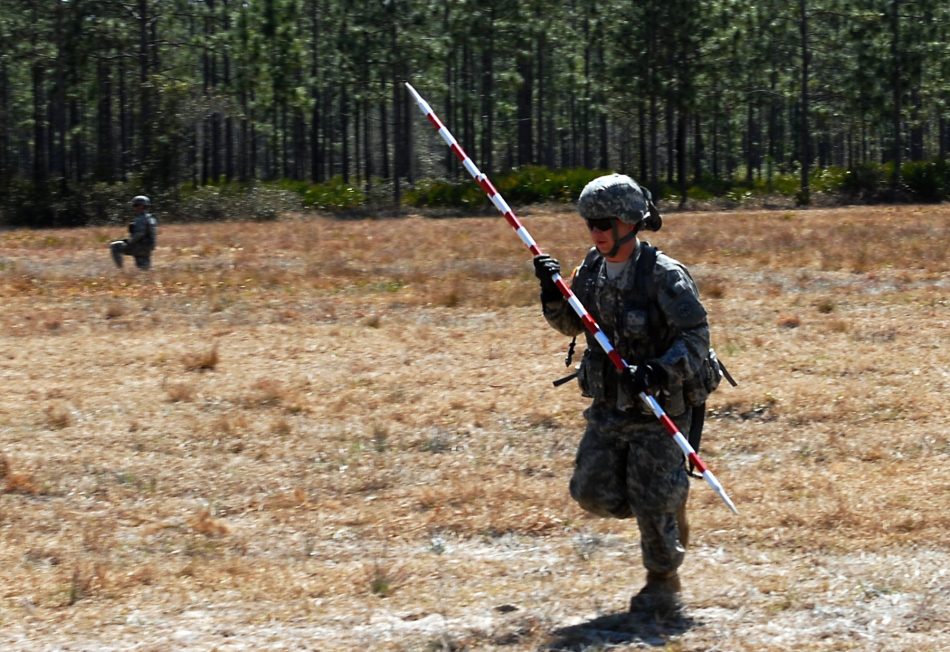
Before the guns are deployed an artillery battery a survey device known as an aiming circle or director is set up to the left front of the battery. It has a compass in it to allow it to aim the guns in the desired direction towards the enemy. The director is near the top of the photo on the high ground near the tree.
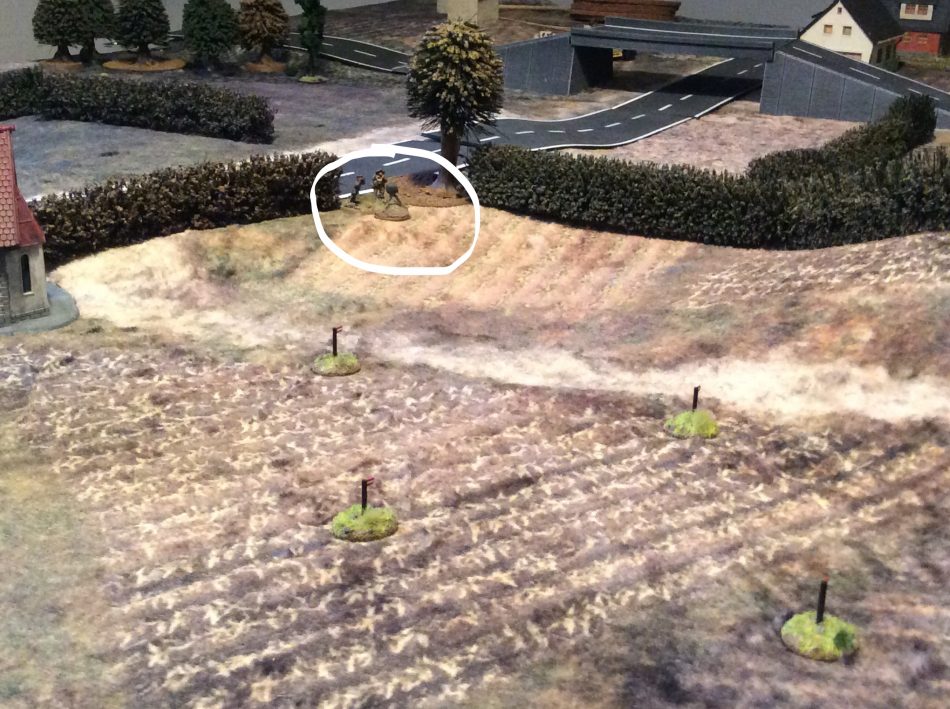
Here is a picture of a US M2A2 Aiming Circle (Director).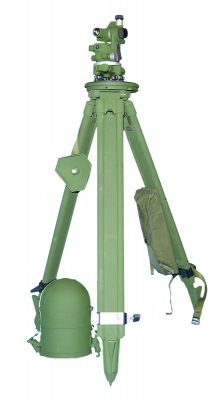 The director shoots an angle to each gun and writes it down for when the guns arrive to set up over those markers.
The director shoots an angle to each gun and writes it down for when the guns arrive to set up over those markers.
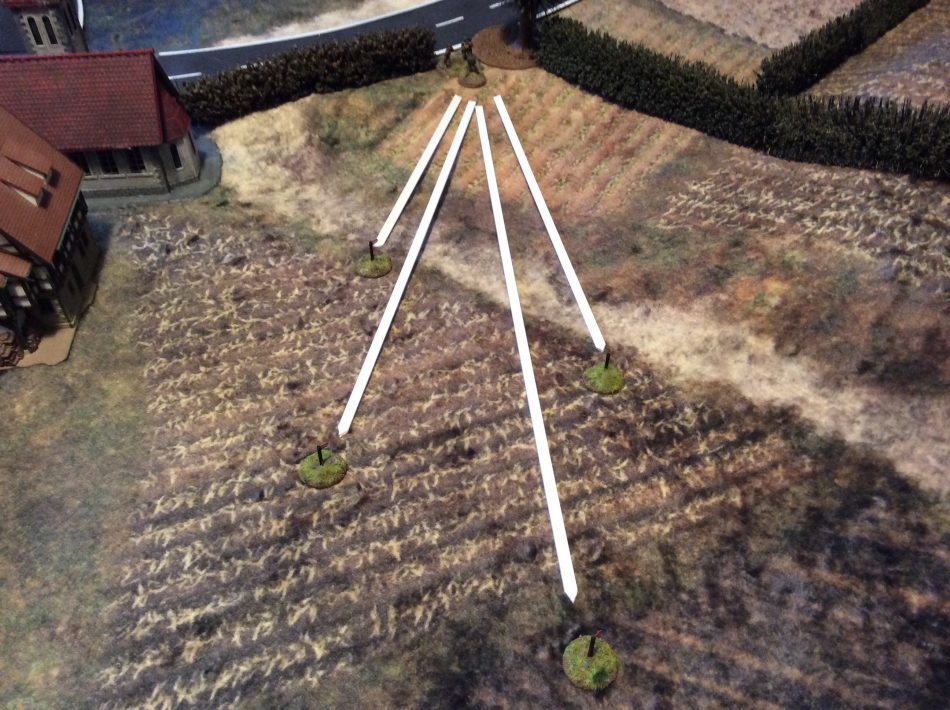
The Troop Sergeant Major (TSM) leads the guns onto the position and the guns stop with their sights as close as possible to the marker.
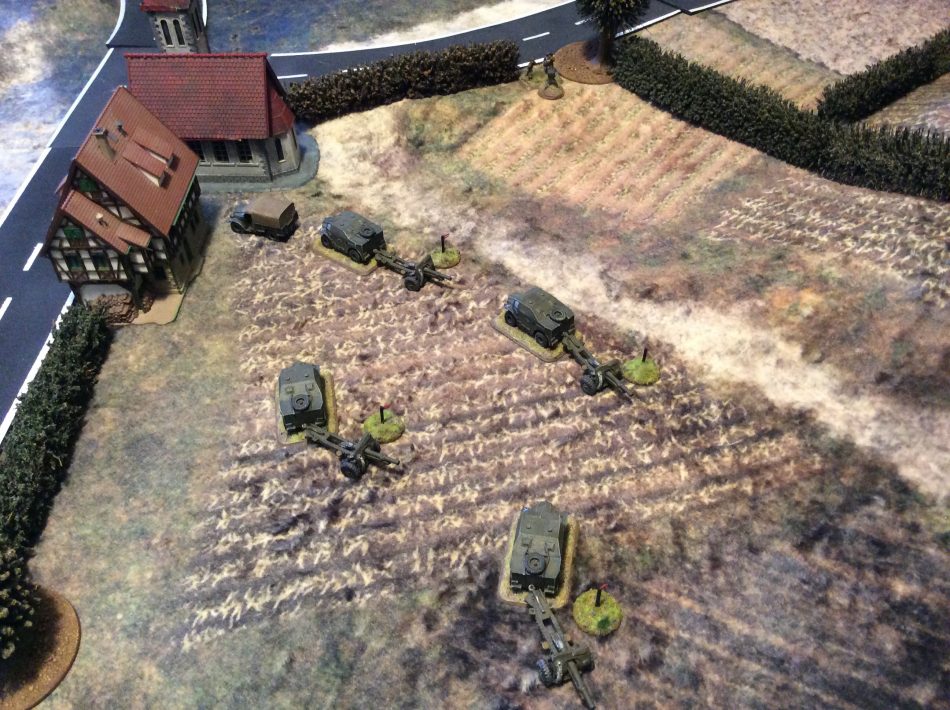 The officer at the director shouts those angles that he had written down earlier to the guns. The gun sights then set that angle and moves the gun left or right until the director is centred in the sight. As long as the director is visible in the centre of the sight, the gun will be pointing in the desired compass bearing. The gun will report back the angle it has to the director. If it agrees with the director the gun will be ordered to record itself. If not, the director sends a second angle. The guns who got their sites exactly over the gun markers usually don’t need that second angle.
The officer at the director shouts those angles that he had written down earlier to the guns. The gun sights then set that angle and moves the gun left or right until the director is centred in the sight. As long as the director is visible in the centre of the sight, the gun will be pointing in the desired compass bearing. The gun will report back the angle it has to the director. If it agrees with the director the gun will be ordered to record itself. If not, the director sends a second angle. The guns who got their sites exactly over the gun markers usually don’t need that second angle.
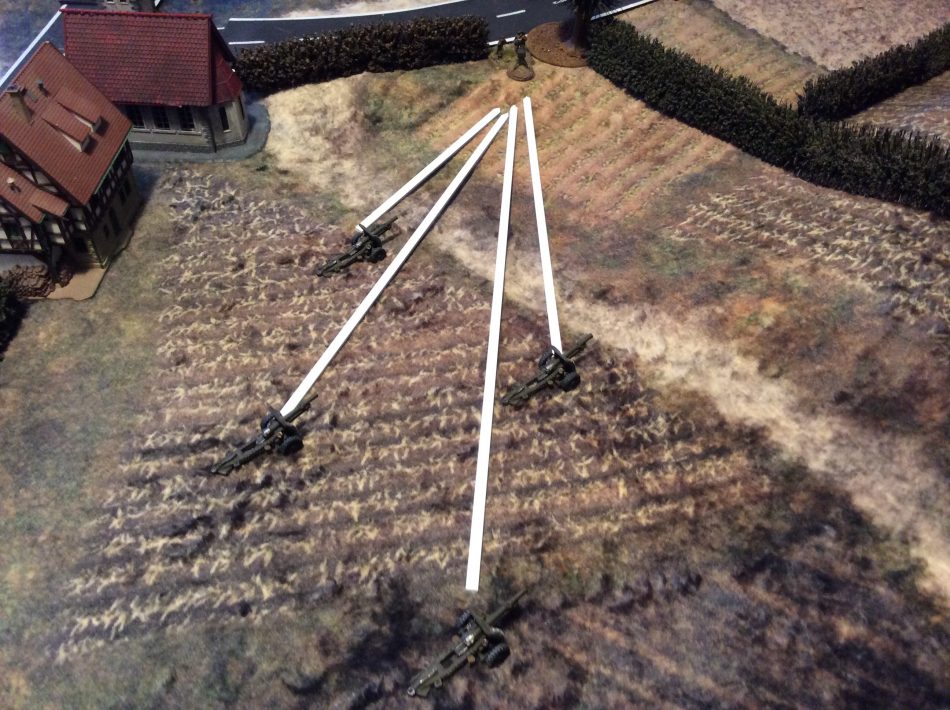 Now the gun will record itself so that it is not always reliant on the director. It does this in two ways, by using a distant aiming point like a tower far off in the distance or by the use of aiming posts spaced 25 or 50 metres apart away from the gun.
Now the gun will record itself so that it is not always reliant on the director. It does this in two ways, by using a distant aiming point like a tower far off in the distance or by the use of aiming posts spaced 25 or 50 metres apart away from the gun.
So, the gun will send out the first aiming post 25 or 50 metres to the left front of the gun and plant it. The second post will go an equal distance and be planted so that both posts are lined up with the sight. The posts go out left front so that the sight won’t be obstructed by the gun barrel. The aiming posts can also be set up right rear for the same reason.
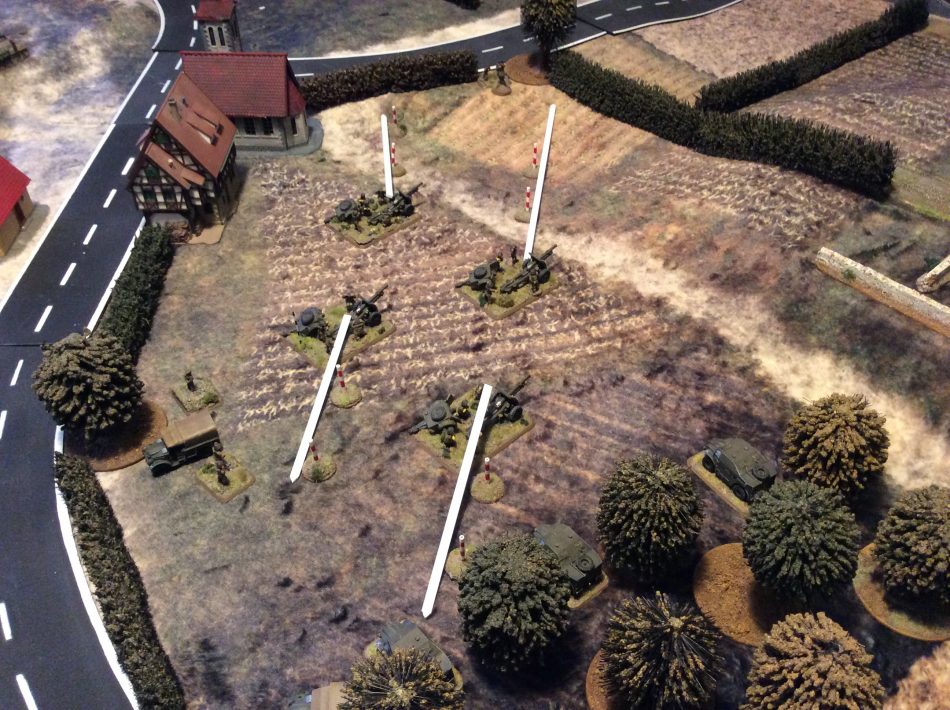 The gun then records the angle to the posts. When a fire mission is received it will contain the bearing or azimuth to the target. That bearing is applied on the sight (which will turn) and the traverse wheel is turned until the sight is lined up with the aiming posts. Once that occurs the gun knows that it is on the correct bearing. Keep in mind that the gun sight has two scales, one for the bearing of fire and one for angles to the director and aiming posts.
The gun then records the angle to the posts. When a fire mission is received it will contain the bearing or azimuth to the target. That bearing is applied on the sight (which will turn) and the traverse wheel is turned until the sight is lined up with the aiming posts. Once that occurs the gun knows that it is on the correct bearing. Keep in mind that the gun sight has two scales, one for the bearing of fire and one for angles to the director and aiming posts.
Now imagine all the guns in the battery are doing this at the same time with lots of yelling of numbers back and forth between the director and the guns. Everyone is racing to be recorded as the guns can’t answer a call for fire until they are recorded. For you mathematicians out there, everything in the artillery is based on the right angle triangle. Once the guns are all recorded and stores and ammunition are off loaded onto the gun platforms, the TSM collects the gun tractors and takes them to the “Wagon Lines” located a few hundred metres away from the guns. In the photo examples above I removed the gun tractors right away to make the photos less cluttered.
If you look at the furthest gun on the left you will notice a much taller white and black post. That is known as the battery centre marker. Or in the case the troop centre marker. Its is located in the centre of the position and is used for survey purposes. I mount them on one gun in each troop/battery to show the designated command stand. Today survey has been replaced by GPS. Before GPS, the guns were located based on the officer’s map reading and grease pencil mark until survey could reach the gun position with a more accurate position.
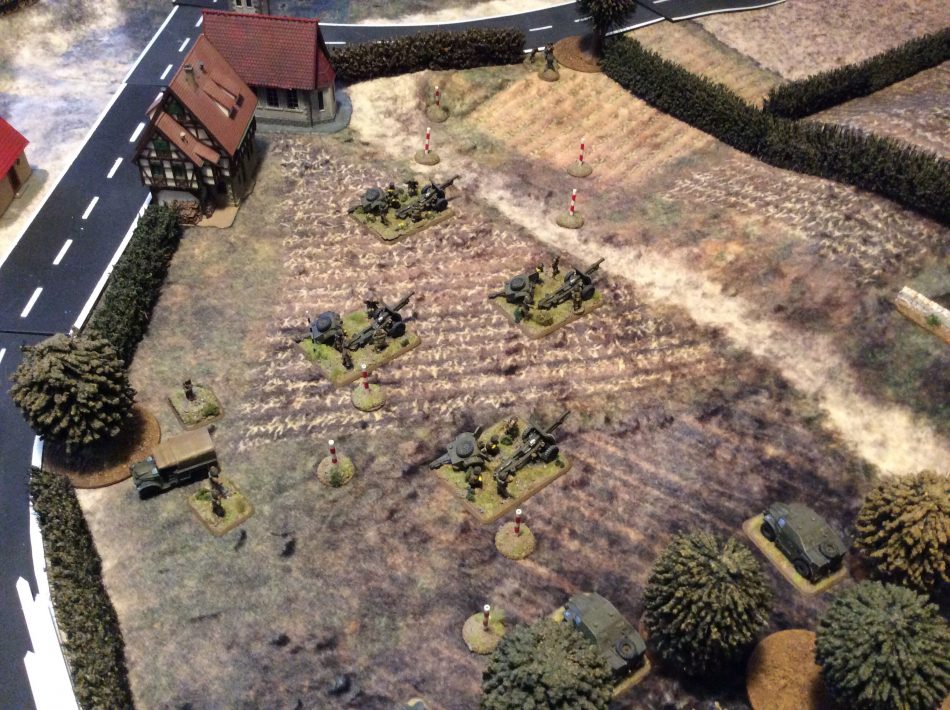
If you look at the furthest gun on the left you will notice a much taller white and black post. That is known as the battery centre marker. Or in the case the troop centre marker. Its is located in the centre of the position and is used for survey purposes. It should of course, be more to the centre, but I mount them on one gun in each troop/battery to show the designated command stand. Today survey has been replaced by GPS. Before GPS, the guns were located based on the officer’s map reading and grease pencil mark until survey could reach the gun position with a more accurate position.
Now we see he troop ready to conduct fire missions. Ammunition is being readied. Survey has commenced. The Command Post has already reported “ready” along with their location. The gun tractors are in the wagon lines. Though they would be well into the woods. I just placed them so they would be more visible. Cam nets will be going up soon, slit trenches will be dug and the local defence plan will be developed.
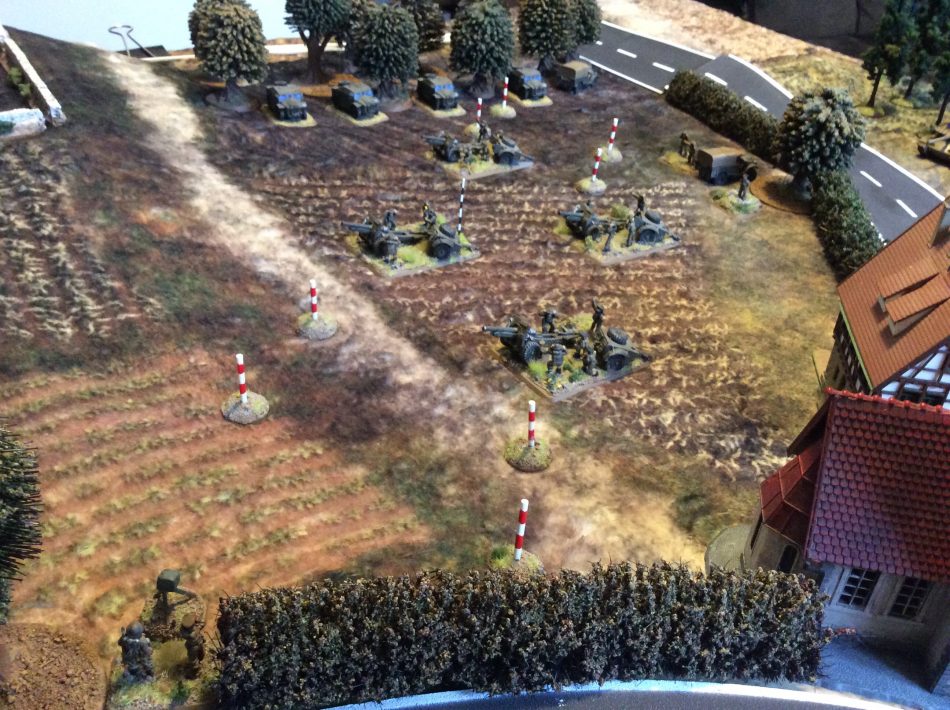
At last light, Tritium (a radioactive isotope) powered lights are attached to the aiming posts so that they can be used at night. These lights do not require batteries or any other power source and will last for decades.
Collimators came into common use after WW2 as a replacement for aiming posts. Aiming posts being relegated to a back up or secondary system. As you can see in the photo below they can be set up closer to the gun eliminating the shouting and hand signal method of planting aiming posts. The site is located in what looks like a small tv set on top of the M109’s turret. It is also visible in all weather conditions. I’m not going to go into too much detail as I’ve never worked with a collimator (I had left the gun line and gone up to work as a FOO by the time they showed up in my unit) and because this is an article about aiming posts.
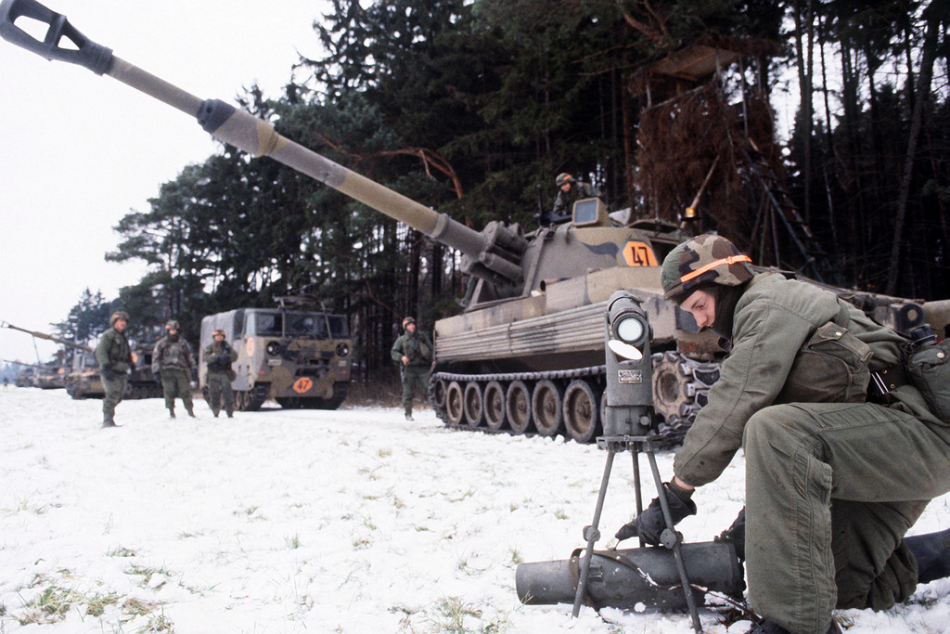
Here is a shot of a Canadian gun position in Afghanistan during ammo resupply. Note that they are still using aiming posts along with the collimator.
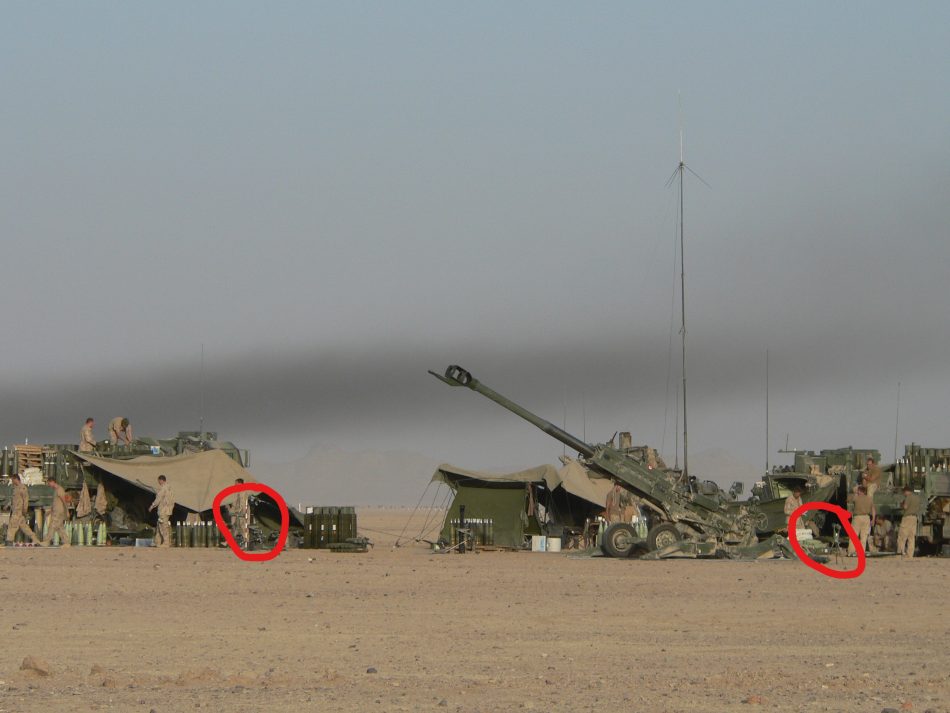
So, if those red and white poles are only used for indirect fire weapons, what are those poles on direct fire weapons like anti tank guns and tank destroyers? They are just unexciting cleaning staves or rods. They come in two or three parts depending on the length of the gun barrel and come with a variety of attachments, such as a bore brush for cleaning (though in a pinch, with 105mm guns a roll of toilet paper would fit just fine). There is also an attachment commonly known as the “suicide cone”.
If there is a misfire on the gun the detachment will wait a short period of time hoping that the propellant will eventually explode firing the round out of the barrel. If not, the suicide cone is attached to the cleaning stave, the barrel is lowered and the shell is pushed back down the barrel through the breech. It is shaped like a cone, so that it does not hit the fuse. It can also be used if the wrong ammunition is loaded or if the gun must be unloaded and there is not safe area to fire it into.
In practice we usually stored our aiming posts in canvas bags and put them in the back of the truck. They could fit on the trails of the gun, but there was always the chance they could fall off on bumpy roads. Same with the cleaning staves. Now if you want to be historically accurate, if your gun is deployed the aiming posts should be out and assembled, not on your trails.
My home made aiming posts and gun markers.
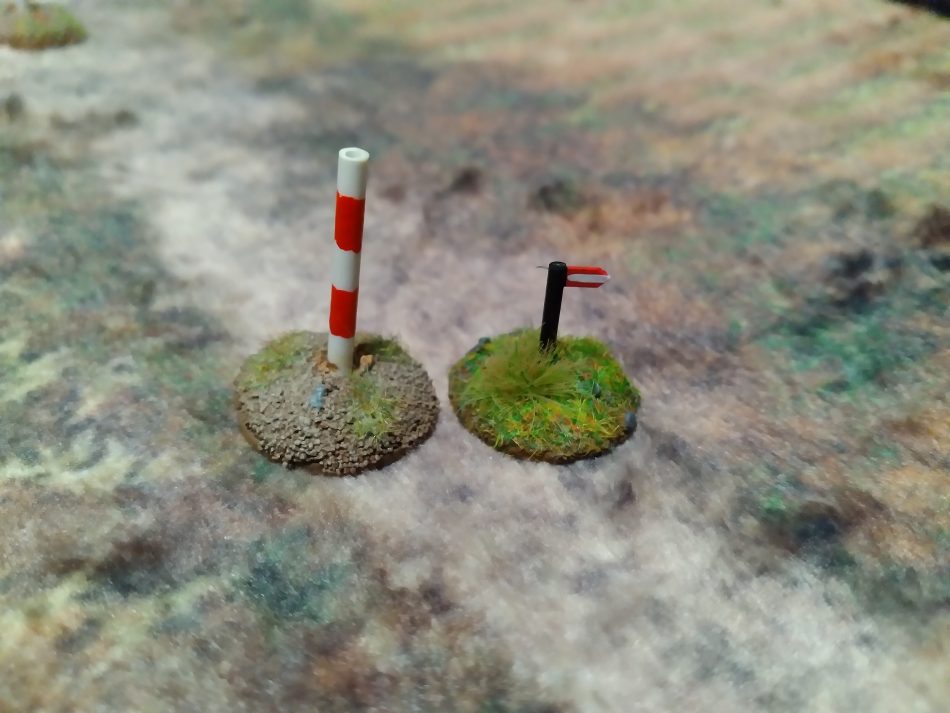
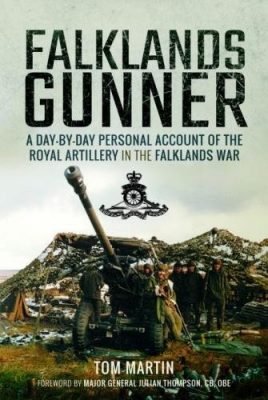 Hopefully those with red and white poles on the sides of their tanks or anti tank guns will now be getting out their green and brown paint and start covering over those red and white poles.
Hopefully those with red and white poles on the sides of their tanks or anti tank guns will now be getting out their green and brown paint and start covering over those red and white poles.
I recommend this book for those who would like some further reading on the artillery: Falklands Gunner: A Day-by-Day Personal Account of the Royal Artillery in the Falklands War, by Tom Martin.
This is a rare book in that it covers the artillery from the perspective of the gunline and doing all of their calculations manually without the aid of computers. And don’t expect to read about the wagon lines. They had no vehicles, so the guns were air lifted by helicopter and manhandled from there.

Used these in Mortar Platoon. There is another use for these poles. They can be used to survey over longer distances. Using the aiming circle, one can not only get direction but also distance to the poles. Their alternate colours are a fixed measurement (I seem to remember 10 cm) and by placing the stadia rods directly on the pole, you simply count the red/white parts between stadia lines and voila: you have your distance to the pole.
The poles can also be used to indicate run up positions for AFVs. In a defensive position, for example, the vehicle adopts its position. Then the pole is placed where the driver can drive up to it and then the vehicle can adopt that position on call, day or night.
Thanks for posting this!
I believe we used bigger black and white posts for survey. And yes a friend of mine of the Royal Canadian Regiment persuasion said they could be used for run ups. I didn’t want to mention it because we would be seeing even more red and white poles on peoples models.
I resemble that persuasion! 😉
For us in mortars we had the black and whites for survey. The red and white was The Pole (so to speak) reserved for use on the gun line.